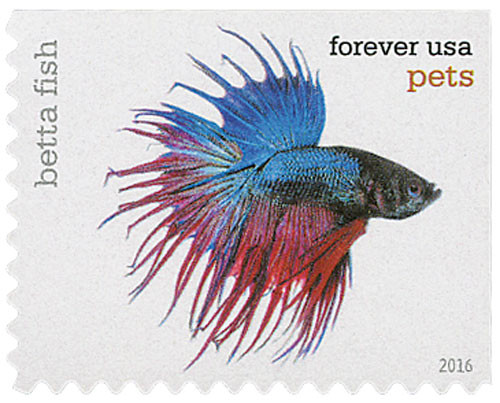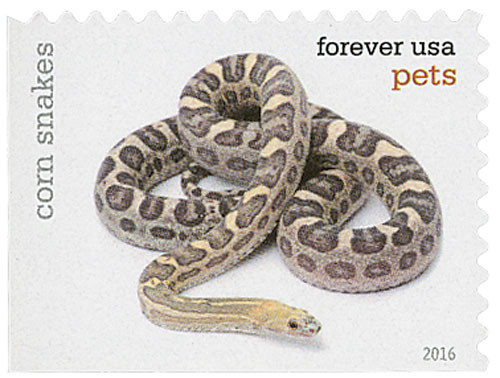
# 5109 - 2016 First-Class Forever Stamp - Pets: Hamsters
US #5109
2016 Hamster – Pets
- Pictures a hamster
- Part of the 20-stamp Pets set honoring the wide range of animals we keep as companions
Stamp Category: Commemorative
Set: Pets
Value: 47¢ First Class Mail Rate (Forever)
First Day of Issue: August 2, 2016
First Day City: Las Vegas, Nevada
Quantity Issued: 400,000,000
Printed by: Ashton Potter (USA) Ltd.
Printing Method: Offset
Format: Double-sided Booklet of 20
Tagging: Nonphosphored type III, block tag
Why the stamp was issued: To celebrate the role our pet hamsters play in making our lives more enjoyable.
About the stamp design: Pictures a photograph by Eric Isselée of a hamster.
First Day City: The First Day of Issue Ceremony was held at the SuperZoo National Show for Pet Retailers at the Mandalay Bay Resort in Las Vegas, Nevada.
About the Pets set: The USPS created 20 stamps to celebrate the many different animals we humans keep as companions. Each stamp pictures one species: puppies, betta fish, iguanas, hamsters, goldfish, kittens, rabbits, tortoises, guinea pigs, parrots, corn snakes, mice, hermit crabs, chinchillas, gerbils, geckos, cats, horses, parakeets, and dogs.
History the stamp represents: Natives of the deserts of Asia, hamsters were first spotted in 1839, but didn’t appear again until 1930. A zoologist discovered a litter in Syria and took them to his research lab in Jerusalem. Only three survived the journey, but most golden hamsters today have descended from them.
Hamsters are hoarders by nature. In the Middle East, farmers harvest their fields and then dig into hamster “granaries” as well. They usually find between 30-60 pounds of grain the hamsters have stored for the winter in each burrow.
Pet hamsters also show this hoarding behavior. When awake, hamsters are constantly busy – and their activity usually involves shredding, chewing, burrowing, and moving things into their hidden dens. Like squirrels and chipmunks, hamsters use their cheek pouches to carry items.
Although solitary creatures, hamsters love to play and enjoy interacting with people. Care must be taken though, as they are masters at escaping and eluding capture. Also, when considering buying a hamster, one must keep in mind they are nocturnal and will be active most of the night. Keeping a hamster cage in a bedroom is not recommended. Otherwise, hamsters require little maintenance, are fun and comical to watch, and can make great pets.
US #5109
2016 Hamster – Pets
- Pictures a hamster
- Part of the 20-stamp Pets set honoring the wide range of animals we keep as companions
Stamp Category: Commemorative
Set: Pets
Value: 47¢ First Class Mail Rate (Forever)
First Day of Issue: August 2, 2016
First Day City: Las Vegas, Nevada
Quantity Issued: 400,000,000
Printed by: Ashton Potter (USA) Ltd.
Printing Method: Offset
Format: Double-sided Booklet of 20
Tagging: Nonphosphored type III, block tag
Why the stamp was issued: To celebrate the role our pet hamsters play in making our lives more enjoyable.
About the stamp design: Pictures a photograph by Eric Isselée of a hamster.
First Day City: The First Day of Issue Ceremony was held at the SuperZoo National Show for Pet Retailers at the Mandalay Bay Resort in Las Vegas, Nevada.
About the Pets set: The USPS created 20 stamps to celebrate the many different animals we humans keep as companions. Each stamp pictures one species: puppies, betta fish, iguanas, hamsters, goldfish, kittens, rabbits, tortoises, guinea pigs, parrots, corn snakes, mice, hermit crabs, chinchillas, gerbils, geckos, cats, horses, parakeets, and dogs.
History the stamp represents: Natives of the deserts of Asia, hamsters were first spotted in 1839, but didn’t appear again until 1930. A zoologist discovered a litter in Syria and took them to his research lab in Jerusalem. Only three survived the journey, but most golden hamsters today have descended from them.
Hamsters are hoarders by nature. In the Middle East, farmers harvest their fields and then dig into hamster “granaries” as well. They usually find between 30-60 pounds of grain the hamsters have stored for the winter in each burrow.
Pet hamsters also show this hoarding behavior. When awake, hamsters are constantly busy – and their activity usually involves shredding, chewing, burrowing, and moving things into their hidden dens. Like squirrels and chipmunks, hamsters use their cheek pouches to carry items.
Although solitary creatures, hamsters love to play and enjoy interacting with people. Care must be taken though, as they are masters at escaping and eluding capture. Also, when considering buying a hamster, one must keep in mind they are nocturnal and will be active most of the night. Keeping a hamster cage in a bedroom is not recommended. Otherwise, hamsters require little maintenance, are fun and comical to watch, and can make great pets.















